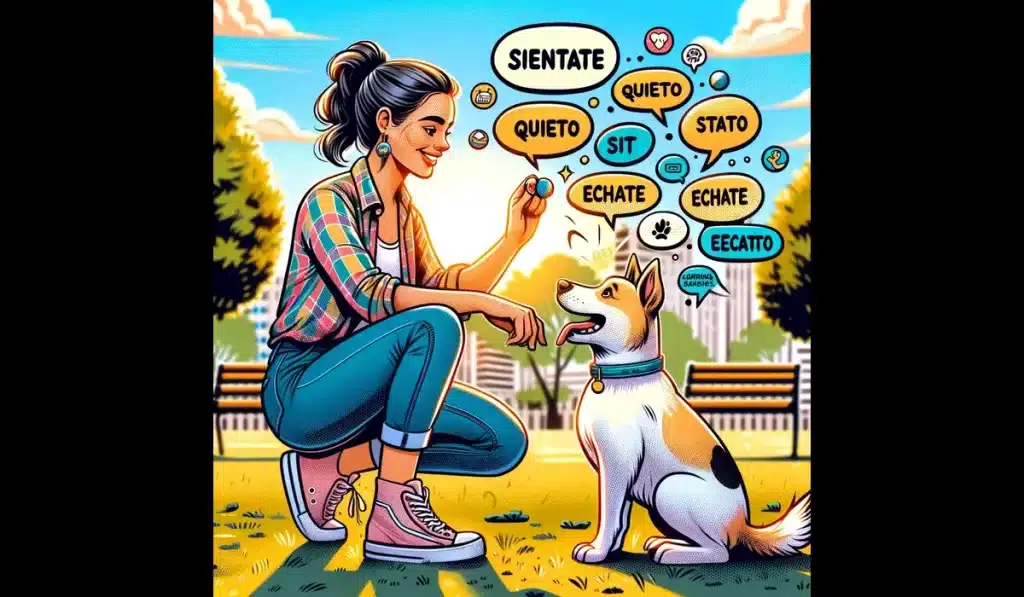Summary
“Perro” (male) and “perra” (female) are the standard Spanish words for dog. Affectionate terms include “perrito/a” (small dog/puppy) and “cachorro/a” (puppy). Mexican slang is “firulais” (often for strays). “Can” is a formal term. Popular social media terms are “lomito,” “peludo,” and “peludito.” Regional slang like “chusco” (Peru) also exists. Useful Spanish commands include “Siéntate” (Sit), “Quieto” (Stay), “Échate” (Lie down), “Trae” (Fetch), and “Ven aquí” (Come here). Training in Spanish creates a unique bond and provides mental stimulation. Be patient and consistent when teaching your dog new commands in Spanish.
How to Say Dog in Spanish?
In Spanish, the feminine ones are called Perra, whereas the masculine ones are known as Perro. It is a standard term for the dog in Spanish; however, there is no single term for a thing in Spanish.
Here, a thing can be called in several ways. Let us see how many different ways a dog can be called in Spanish.
Perro
This is the most frequent term for a dog in Spanish. This term is used in formal and informal situations and is well-known in all Spanish-speaking countries.
Perro is the common term for all types of dogs; however, gender is very important in Spanish. So, to refer to a female dog, you must call it perra. But you will need to keep in mind the heavily rolled Spanish “rr” and slightly rolled Spanish “r” as Pero means “but” whereas Perro means dog.
Example: ¿No te gustan los perros grandes? Don’t you like big dogs?
Perrito
If you want to call your dog lovingly, then Perrito is used. Perrito is nothing but a cute little dog. It is an affectionate term used to refer to small dogs.
This term is used when you want to show closeness to your dog. Puppy in Spanish is called Perrito, the word’s male form. If your puppy is a girl, you can say perrita. Both Perrito and Peritta can be used in formal or informal contexts. Perrito or Perrita can be used to refer to small and big.
Example: Mi perrito es el más tierno de todos los perros: My doggy is the sweetest dog of all.
Cachorro
Cachorro means puppy in Spanish. It refers to the youngest age in your dog’s life.
When you have young or small dogs around, you can call them Cachorro. If you want to call a male dog, use Cachorro, and a female is called Cachorrita. Sometimes, you can affectionately call your puppy Cachorrita.
In Spanish, cachorro is a term used to refer to all baby mammals like lions, tigers, dogs, and bears.
Example: Voy a regalarle a mi hija un cachorrito: I’ll give my daughter a puppy.
Firulais
Firalais is a Mexican slang word used to refer to dogs. Mexicans use this mainly for stray dogs; however, few use it to refer to their dogs. This word came from popular mythology when Mexican migrants shifted to the United States.
These migrants who came with dogs were told to get dogs free of lice, which gave rise to the word Firalais. It can also be used to call a dog when you are unaware of its name.
Example: El firulais rompió el jarrón de mi mamá The dog broke my mom’s jar
Can
‘Can,’ plural of ‘Canes,’ refers to any dog formally. Male, as well as female dogs, can be called ‘Can.’ Since it is a formal term used in publications, news, documentaries, and books, Hound is a direct translation of Can. Still, it can be used to refer to any dog.
Spanish is a romance language, and most of its vocabulary is derived from Latin. It is similar to the Latin word Canine used in English.
Example: Los canes atacaron a una persona . The dogs attacked a person.
Chusco
In Peru, the term used for street and mixed breed dogs is Chusco. It can be translated as ‘mutt’ or ‘dog’. Just as Chusco is used in Peru, few other Spanish-speaking countries may have terms like
Mexico – Mertizo, Caquero – Costa Rica, Calingo – Honduras.
Example: Nuestro perro es mestizo. Our dog is a mutt.
Lomito
Lomito has become a popular Spanish word on the internet, just like ‘peludo’ and ‘peludo.’ It is a very affectionate and cute way to call your dog. ‘Lorito’ can be used to refer to all types of big, small, female, and male dogs and puppies. It has no direct translation; however, the meaning is closer to ‘dog’ or ‘doggy.’
Example: Gustavo va con su lomito a todos lados. Gustavo goes everywhere with his dog.
Peludo / Peludito
Peludo means hairy. Even if this word is used for hairy pets, you can connect it more with dogs. It is a well-known word on social media for dogs and is a part of casual conversations. Peludito is a more loving word than Peludo.
Peludo and Peludito are used to refer to male and female dogs. These words are directly translated as hairy and furry but are used for dogs.
Example: Linda extraña a su peludito. Linda misses her furry
El Guau Guau
It is an example of onomatopoeia, where a word sounds like the sound it represents. El Guau Guau is more popular among kids as it is easier to pronounce than ‘perro.’ It is also a cute and informal way of calling your dog.
Even though El Guau Guau directly translates the word ‘Woof-Woof,’ it means dog here.
Example: ¿Te gusta el guau guau? Do you like that dog?
Perrihijo
If you love your dog as one of your family, the most popular term for a dog in Spanish is used. It is Perrihijo, a combination of ‘perro’ and ‘hijo.’ This word is often used when you love your pet and call it playfully and lovingly. Unfortunately, it does not have a direct translation, but it means dog-son.
Example: ¿Cómo está tu perrihijo? How is your dog-son?
Sabueso
The Bloodhound dog is Sabueso. Sabueso are referred to as dogs who have jobs to do, like police or a tracker dog. This Spanish word refers to a few breeds of dogs with a great sense of smell and good hunting skills. It is a formal way to address working dogs,
for example: La policía consiguió un sabueso para capturar criminales: The police got a hound dog to catch criminals.
Lazarillo
They are also called seeing dogs. This term is used for dogs that help people with visual disabilities with daily duties. It may not always be used on dogs; however, natives will get the mental image of a dog with this word.
Example: Necesitamos un lazarillo para papá, ahora que ha perdido la vista: We need a dog (a guide dog) for dad now that has lost his sight.
How to Command Your Dog in Spanish?
It is not very easy to control your pets. They may respond to our commands based on their mood and environment. If you are learning Spanish and wish to teach commands to your dog in the same language, below are a few basic commands:
- A few common commands that your dog should know are ‘sit’ and ‘stay.’ In Spanish, sit and stay are sientate and quieto, respectively. Quieto means quiet or calm but is used as a verb in Spanish.
- A few common words that you have to teach your dog are
Échate- “lie down.”, dese la vuelta- “roll over, Trae! – “fetch”, espera- “wait”
- Come here in Spanish – In Spanish-speaking countries, leashes are not common, so you will need to know how to call your pet back when you take them walking in the park. Come – venir and here – aqui.
By now, you might have realized that it’s not only about calling your dog in Spanish. It’s about taking the time and effort to learn a new language for the love of your pets. So get yourself and your amigo trained, and enjoy your days.


